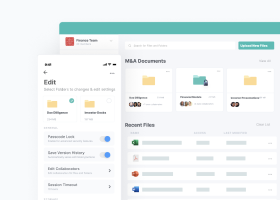Financial Privacy: What Is It?
Let’s jump in and learn:
- What Is Financial Data Protection?
- What Are the Examples of Financial Data in Data Privacy?
- What Is the Purpose of the Consumer Financial Protection Act?
- What Does Gramm-Leach-Bliley Act Do?
- How Can Your Organization Protect Personal Data and Financial Data?
- Financial Data Protection Enables Secure Digital Transformation
What Is Financial Data Protection?
Financial data protection is the defense of all digital and physical assets, as these contain some of the most sensitive and valuable information in the public realm. Any organization that handles financial information of any kind needs financial data protection—from banks and insurance to securities brokers and e-commerce websites, none are exempt. Always a priority, financial data protection has become even more urgent as cybercrime becomes ever more sophisticated with financial institutions in its crosshairs.

In addition, as the industry accelerates its digital transformation and consumers become digital-first, the attack surface has grown exponentially, increasing financial data protection’s importance.
With these changes come stricter regulations that bring heavy fines and penalties for breaches in financial data protection and the exposure of sensitive information. Financial regulations require banks, credit unions, insurance agencies, savings institutions, and securities firms to maintain the highest levels of financial data protection.
Among the biggest threats that financial data protection aims to address are:
- Malware
- Manipulated data
- Non-secure third-party services
- Spoofing
- Unencrypted data
What Are the Examples of Financial Data in Data Privacy?
Any information related to an individual or business’s financial account or transaction is considered financial data. Anyone using financial information must employ financial data protection to keep the information secure, since it could be used for identity theft and other nefarious purposes.
Examples of financial information that require financial data protection are:
- Credit card numbers
- Credit information
- Credit rating data by third-party credit analysis firms
- Customer account numbers
- Financial statements
- Payment histories
- Purchase history
- Sales data
- Transaction data
What Is the Purpose of the Consumer Financial Protection Act?
The Dodd-Frank Wall Street Reform and Consumer Protection Act, known as Consumer Financial Protection Act and often referred to as Dodd-Frank, is an amendment to the National Bank Act. The purpose of the Consumer Financial Protection Act is to identify and explain the standards that apply to banks in the United States. The Consumer Financial Protection Act increased oversight and refined the consumer finance laws governing financial transactions to protect consumers in these transactions, driving an increased need for financial data protection solutions.
The Consumer Financial Protection Bureau was created as a result of the Consumer Financial Protection Act. The Bureau is responsible for enforcing financial laws that affect consumers, including the Consumer Financial Protection Act. The Consumer Financial Protection Bureau works to make finances more clear for consumers and supervises banks, lenders, and other financial institutions. Depository institutions with more than $10 billion in assets are under the supervision of the Bureau, which also has examination and enforcement powers for financial industry participants that offer consumers financial products.
The Consumer Financial Protection Act gave the Bureau broad authority to:
- Protect consumers from unfair, deceptive, or abusive acts and practices
- Control lender data collection, which was previously the responsibility of the Federal Reserve under the Home Mortgage Disclosure Act
- Oversee mortgage lending and servicing disclosures and requirements set forth in the Truth in Lending Act and the Real Estate Settlement Procedures Act
- Create and manage a database where consumers can submit complaints about financial service companies and products
What Does Gramm-Leach-Bliley Act Do?
The Financial Modernization Act of 1999, commonly known as the Gramm-Leach-Bliley Act, Gramm-Leach-Bliley, or GLBA, requires financial institutions are required to take steps to protect the privacy of consumers’ finances, giving rise to enhanced financial data protection solutions. The Federal Trade Commission (FTC) is one of the federal agencies that enforces provisions of Gramm-Leach Bliley.
GLBA covers not only banks, securities firms, insurance companies, and companies providing many other types of financial products and services. Under the law, the FTC enforces:
- The Financial Privacy Rule
“The regulations require financial institutions to provide particular notices and to comply with certain limitations on disclosure of nonpublic personal information. A financial institution must provide a notice of its privacy policies and practices with respect to both affiliated and non-affiliated third parties and allow the consumer to opt out of the disclosure of the consumer’s nonpublic personal information to a non-affiliated third party if the disclosure is outside of the exceptions.” - The Safeguards Rule
“The Safeguards Rule requires financial institutions under FTC jurisdiction to have measures in place to keep customer information secure. In addition to developing their own safeguards, companies covered by the Rule are responsible for taking steps to ensure that their affiliates and service providers safeguard customer information in their care.” - A provision designed to prevent individuals and companies from gaining access to consumers’ personal financial information under false pretenses, a practice known as pretexting
The GLBA Safeguards Rule has triggered reassessments of financial data protection systems as the penalties are severe. Failure to comply with the Safeguards Rule can result in significant fines. The FTC can impose penalties of up to $100,000 per violation, with an additional $10,000 for directors and officers.
Among the organizations that are now legally liable for protecting a customer’s financial information under the Safeguards Rule include: financial institutions and almost any organization in the finance industry, such as:
- Mortgage brokers
- Payday loan companies
- Private lenders
- Real estate appraisers
- Tax preparation companies
- Individuals engaged in any of these activities
The Safeguard Rule also extends to third-party operators, such as:
- Companies that make and lease ATM machines
- Credit bureaus and reporting agencies
- Any company that deals with an individual’s nonpublic personal information (NPI)
In addition, GLBA’s Data Security Rule directs that all financial organizations must create, implement, and preserve strict data security programs that contain financial data protection measures (i.e., physical, administrative, and technical) appropriate for the organization’s size and complexity. Not implementing or violating the GLBA financial data protection directives could lead to penalties of up to $1 million.
How Can Your Organization Protect Personal Data and Financial Data?
In order to protect personal data, organizations have various strategies for financial data protection at their disposal. Understanding financial data protection best practices is an important step toward protecting sensitive, regulated information. The following are several financial data protection measures to consider.
Audit access to sensitive data
All access to sensitive should be recorded and tracked to ensure financial data protection. In addition, regular assessments of who has access to sensitive information should be done to determine if it is still needed. When access to sensitive information is not needed, those privileges should be suspended or revoked to reduce threat vectors.
Backup data
Data backup plays an essential role in financial data protection even though it prevents a cyberattack. In the event of a compromise due to a cyberattack or an innocent mistake by an insider, data backups ensure that operations can resume as quickly and with as little operational disruption as possible. Organizations are encouraged to follow the 3-2-1 strategy for data backup, which means keeping three copies of backups on two different media, with one stored off-site or in the cloud.
Check credit reports and bank activity regularly
For smaller organizations, credit reports and bank activity can reveal indicators of cybersecurity issues. Regularly monitor credit card activity and quarterly or monthly credit reports to identify any unexpected changes. In addition, check bank statements thoroughly to see if there are any unapproved transactions. This is a fairly low-budget way to assess risk or potential issues and the need for a financial data protection system.
Conduct periodic risk assessments
Routine risk assessments provide valuable insight into changing financial data protection requirements and gaps in existing security IT infrastructures.
Create Incident Response Plans
Financial data protections should include having a plan in place for how to respond in the event of an incident to minimize impact. An incident response plan should include:
- Clarify what is or isn’t a cybersecurity incident.
- Directions about which authorities need to be notified once an incident has been detected
- First steps to be taken in the event of a cyberattack
- Instructions for how to respond to different types of cybersecurity incidents
- Instructions for how to restore lost data
Many regulations require organizations to differentiate between personal data and sensitive personal data. While this requires an extra step, it helps organizations focus financial data protection efforts by allowing more resources to be focused on protecting sensitive information, which is at higher risk of compromise.
Encrypt sensitive data
Every financial data protection plan should require encryption for sensitive data and network access as it is a proven method of securing data at rest, in transit, and in use.
Enforce strong passwords
Implementing and enforcing strong passwords helps eliminate one of the most common points of entry that unauthorized users leverage to access employee accounts to initiate data breaches. Using strong passwords in conjunction with single sign-on and multi-factor authentication has been proven to close this security gap.
Implement role-based access
Establishing role-based access is an effective internal safeguard for financial data protection. With role-based access, users are given only the minimum access to files, folders, and systems they require based on their roles.
Manage third-party risk
Minimize risks posed by third parties (e.g., partners, suppliers, subcontractors) by:
- Enforcing third parties’ compliance with financial data protection protocols
- Limiting access to critical sensitive information
- Monitoring the activities of all third parties that have access to networks
Leverage cybersecurity frameworks
Cybersecurity frameworks (e.g., NIST Cybersecurity Framework, ISO 27001 and ISO 27002, SOC2) help organizations understand best practices for all areas of security, including financial data protection, meeting data privacy regulations by defining and implementing:
- Data privacy programs
- Process for reviewing, designing, and implementing targeted security systems
- Robust governance models
Monitor user activity
Continuous monitoring of user activity is important for financial data protection as it helps organizations proactively detect suspicious activity to prevent or minimize the impact of cyberattacks. Monitoring should focus on privileged users in any network and those with access to sensitive information and systems.
Prioritize financial data protection
Financial data protection must be a high priority whether it is for overall security concerns, governance directives, or regulatory compliance issues. Best practices recommend creating and enforcing financial data protection systems and conducting regular financial data protection training to ensure that everyone in the organization understands what it is and why it is vital.
Require multi-factor authentication
Multi-factor authentication is fairly easy to deploy and a highly effective form of financial data protection. It eliminates vulnerabilities from employees sharing passwords within their teams or passwords being compromised.
Multi-factor authentication is a way to protect your confidential information, as it requires more than a shareable password. There are a number of options for multi-factor authentication to strengthen financial data security. Among these are an OTP delivered via email or SMS, and biometric authentication, such as fingerprint scans, retina scans, voice recognition, facial recognition, or behavioral biometrics (e.g., keystroke dynamics).
Safeguard relationships with suppliers
Suppliers are critical to most organizations and represent a significant number of transactions. In many cases, suppliers have access to payment information and, in some cases, customers or other sensitive information. Confirming that suppliers have secure payment processing and meet your financial data protection standards is important.
Secure remote network access
As remote teams gain prevalence, they are also bringing more risk. Although remote users can make financial data protection protocols more complex, they are not optional. Remote access controls must be in place to protect data shared over networks. Virtual private networks, or VPNs, can be used to provide secure, regulated access to networks as part of an effective financial data protection program.
Train staff to recognize security threats
Financial data protection systems can be compromised when hackers gain access to networks. Users are often the point of entry when they click malicious links or fall prey to phishing or other social engineering ploys. Regular security training with an emphasis on how it impacts financial data protection is a proven way to help employees avoid becoming the victim of an attack and, therefore, the source of a data breach.
Security awareness programs should include a blend of training and testing drills (i.e., planned and conducted surreptitiously) to make staff aware of what is classified as sensitive information, why it is of the utmost importance to take extra measures to follow financial data protection protocols, and how to identify red flags. In addition, training should detail how staff should respond in the event that an attack is suspected or in progress to minimize the impact of an attack by initiating reactionary financial data protection tactics.
Use cloud-based services
Desktop-based applications or manual systems can create gaps in your financial data security systems due to exposure and dependence on users’ ability to abide by security protocols effectively. Cloud-based applications have layers of security that outperform desktop versions and increase overall financial data protection.
Financial Data Protection Enables Secure Digital Transformation
Always security conscious, institutions that are doing well on this front have taken steps to significantly step-up financial data protection. Financial service providers are also being compelled by laws and regulations to optimize financial data protection to mitigate risks, control costs, and accelerate digital transformation.
Traditional encryption and perimeter security layers are no longer enough. Additional layers of financial data protection are required. Financial data protection solutions continue to evolve to stymie the increasing rates of data breaches and ransomware attacks. Staying abreast of the latest financial data protection solutions is mandatory to maintain an effective defensive security posture.
Egnyte has experts ready to answer your questions. For more than a decade, Egnyte has helped more than 16,000 customers with millions of customers worldwide.
Last Updated: 14th November, 2023



